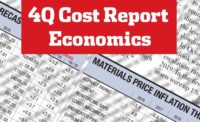Lumber’s escalation rate is slowly declining, after a prolonged period of double-digit price increases. The ENR 20-city average price for the most common types of lumber is up 6.9% over this time last year, after a 10.4% hike at the end of the first quarter of 2018. Following steel tariff-related uncertainty in 2018, price increases have steadied. ENR’s 20-city average price for steel is up 5% in 2019, while IHS Markit expects small hikes in several steel products over the year.
“Prices will try to increase across mid-2019 but the movement will be erratic,” says John Anton, director of steel at IHS Markit. “Look for prices to rally through midyear but stay far below their mid-2018 peak. The average price for 2019 will be below 2018, but above January levels.”
|
Related Link |
Consumption and Cost
ENR’s 20-city average price for cement is up 5%, while IHS Markit predicts a 3.1% increase in 2019. The research firm’s senior economist, Deni Koenhemsi, predicts that “producers are trying to pass on the higher energy costs incurred in 2018.” The Portland Cement Association predicts that total cement consumption will rise 2.3% in 2019 but will cool off somewhat in 2020 and 2021, escalating at 1.8% and 0.5%, respectively.
After large hikes in oil and gas prices in 2018, IHS Markit also predicts decreases across the board in 2019, including a 12% decline for U.S. gasoline as well as a 7.5% drop for West Texas crude oil.
“We have lowered our forecast for natural gas prices through 2019,” says Thomas McCartin, IHS Markit energy analyst. “After the spike in November that helped lift average prices in the fourth quarter to $3.79/MMBtu, prices will fall, averaging $2.77/MMBtu in the first quarter of 2019.” He points out that with winter over, production gains will build inventories, but risks ahead include “a stronger supply or cooler-than-expected summer that could put downward pressure on prices.”
Following a slow start to the year, construction is expected to pick up for the rest of 2019, with activity at roughly the same levels as in 2018, according to Robert A. Murray, chief economist at Dodge Data & Analytics. He cites building work such as the Toyota/Mazda auto assembly plant in Alabama and the Foxconn display plant in Wisconsin, and transportation work such as the new airport terminal in Kansas City as large projects that will provide a boost.
Signs of Slowdown
“On the plus side, federal transportation spending for fiscal 2019 was finalized in mid-February, and included a 2% increase for the federal-aid highway program,” Murray says. “Interest rates have settled back, and inflation has subsided for now. Market fundamentals for office buildings and warehouses have not yet begun to erode.”
But Murray also cautions that U.S. economic growth is set to slow in 2019 with “exports dampened by the slowing global economy.” He adds that “recent surveys of bank lending officers indicate that some tightening of lending standards is now taking place, reflecting a more cautious stance by the banking sector toward commercial real estate loans.”
Wage Rates Climb
Related to labor costs, ENR’s 20-city average posted 1.7% and 1.6% respective increases in the first quarter for common wages, which applies to nonunion labor, and skilled wages, which is based on union worker compensation, compared with the same time last year.
The Construction Labor Research Council (CLRC), which tracks North American organized labor collective-bargaining settlements, reported increases in the 2.6%-3% range for 2018.
“For regions, the largest average percent increase, by far, in 2018 was in the Northwest region and the smallest in the Mountain Northern Plains,” says Carey L. Peters, executive director at CLRC.
Insulators, carpenters and pipefitters/plumbers had the largest increases among the crafts, at 4.7%, 3.9% and 3.7%, respectively. Bricklayers, boilermakers, plasterers and teamsters had the smallest increases, at less than 2.5%.
In the coming year, CLRC “expects to see more of the same,” says Peters. “Small but steady increases, with many over the 3.0% threshold.”







